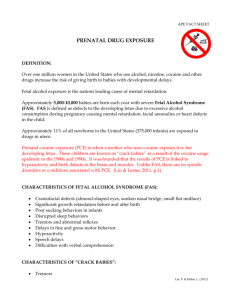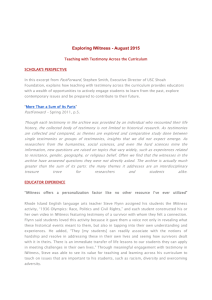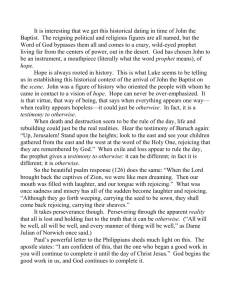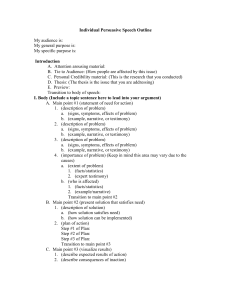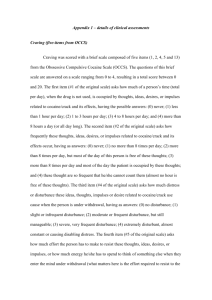FAQ about medical, scientific, psychological and social science
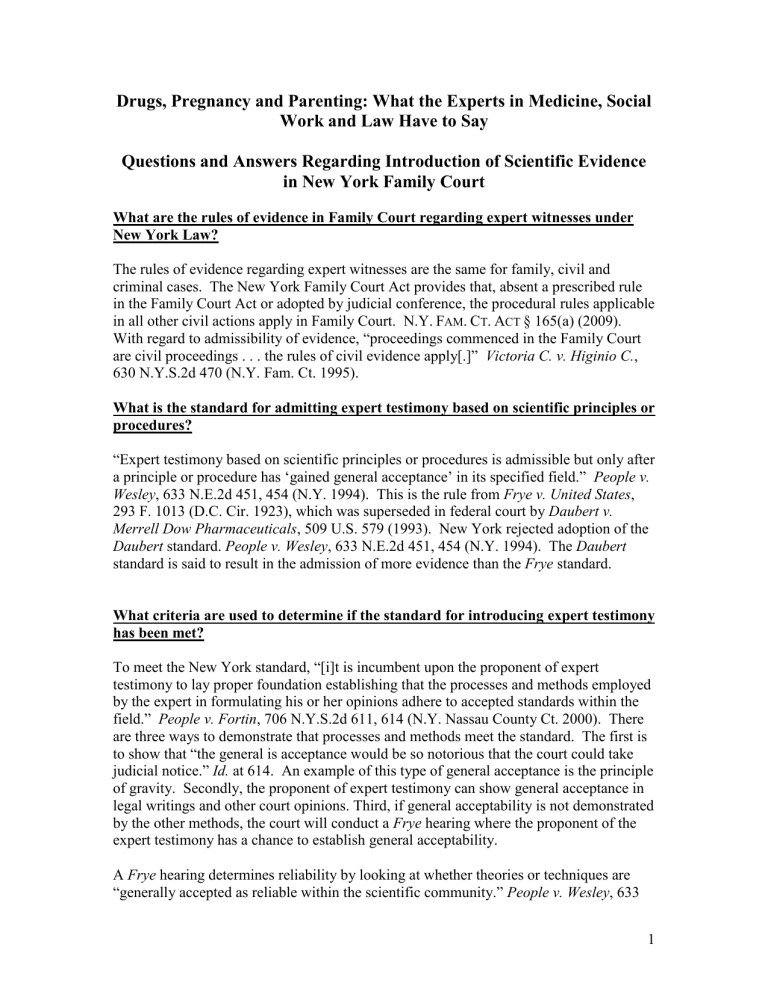
Drugs, Pregnancy and Parenting: What the Experts in Medicine, Social
Work and Law Have to Say
Questions and Answers Regarding Introduction of Scientific Evidence in New York Family Court
What are the rules of evidence in Family Court regarding expert witnesses under
New York Law?
The rules of evidence regarding expert witnesses are the same for family, civil and criminal cases. The New York Family Court Act provides that, absent a prescribed rule in the Family Court Act or adopted by judicial conference, the procedural rules applicable in all other civil actions apply in Family Court. N.Y.
F AM .
C T .
A CT
§ 165(a) (2009).
With regard to admissibility of evidence, “proceedings commenced in the Family Court are civil proceedings . . . the rules of civil evidence apply[.]” Victoria C. v. Higinio C.
,
630 N.Y.S.2d 470 (N.Y. Fam. Ct. 1995).
What is the standard for admitting expert testimony based on scientific principles or procedures?
“Expert testimony based on scientific principles or procedures is admissible but only after a principle or procedure has ‘gained general acceptance’ in its specified field.”
People v.
Wesley , 633 N.E.2d 451, 454 (N.Y. 1994). This is the rule from Frye v. United States ,
293 F. 1013 (D.C. Cir. 1923), which was superseded in federal court by Daubert v.
Merrell Dow Pharmaceuticals , 509 U.S. 579 (1993). New York rejected adoption of the
Daubert standard. People v. Wesley , 633 N.E.2d 451, 454 (N.Y. 1994). The Daubert standard is said to result in the admission of more evidence than the Frye standard.
What criteria are used to determine if the standard for introducing expert testimony has been met?
To meet the New York standard, “[i]t is incumbent upon the proponent of expert testimony to lay proper foundation establishing that the processes and methods employed by the expert in formulating his or her opinions adhere to accepted standards within the field.”
People v. Fortin , 706 N.Y.S.2d 611, 614 (N.Y. Nassau County Ct. 2000). There are three ways to demonstrate that processes and methods meet the standard. The first is to show that “the general is acceptance would be so notorious that the court could take judicial notice.”
Id.
at 614. An example of this type of general acceptance is the principle of gravity. Secondly, the proponent of expert testimony can show general acceptance in legal writings and other court opinions. Third, if general acceptability is not demonstrated by the other methods, the court will conduct a Frye hearing where the proponent of the expert testimony has a chance to establish general acceptability.
A Frye hearing determines reliability by looking at whether theories or techniques are
“generally accepted as reliable within the scientific community.”
People v. Wesley , 633
1
N.E.2d 451, 464 (N.Y. 1994) (Kaye, C.J., concurring). For example, in People v.
Taylor , the Court of Appeals found sufficient acceptance of a theory of rape trauma syndrome on the basis of a recognition by the American Psychiatric Association and notation in the DSM-III that rape could lead to posttraumatic stress disorder. People v.
Taylor , 552 N.E.2d 131, 135 (N.Y. 1990). When there is controversy over whether a procedure or theory is “generally accepted,” the Frye inquiry emphasizes “counting scientists’ votes, rather than on verifying the soundness of a scientific conclusion.”
People v. Wesley , 633 N.E.2d 451, 464 (N.Y. 1994) (Kaye, C.J., concurring) (internal citations omitted). However, Chief Judge Kaye cautioned in Wesley that an absence of controversy may be misleading: it may be indicative of an untried theory rather than consensus. Id.
What does “generally accepted in the scientific community” mean?
The court’s finding of general acceptability does not require that the principle or procedure be universally accepted, but, as Chief Judge Kaye noted, “[i]t is not for a court to take pioneering risks on promising new scientific techniques, because premature admission both prejudices litigants and short-circuits debate necessary to determination of the accuracy of a technique.” People v. Wesley , 633 N.E.2d 451 (N.Y. 1994) (Kaye,
C.J., concurring). Unlike a court applying the Daubert standard, the New York courts do not determine whether the method itself is reliable, instead, the question “whether there is a consensus in the scientific community as to its reliability.” DeMeyer v. Advantage
Auto , 797 N.Y.S.2d 743 (N.Y. Sup. Ct. 2005).
What standards must a witness meet to be qualified as an expert?
In addition to meeting the Frye standard, the expert testimony must be delivered by an expert qualified by the court. A witness’s qualification as an expert are within the discretion of the trial court. “Before the testimony of an expert witness can be received in evidence, the party seeking to offer that evidence has the burden of demonstrating the qualifications that make the witness an expert. Because there are no absolute rules automatically defining whether a witness is an expert or not, various combinations of education, training, and observation or experience may suffice.” In re R.M. Children ,
627 N.Y.S.2d 869, 872 (N.Y. Fam. Ct. Kings County 1995). In the R.M.
case, the family court determined that a clinical psychologist, who’s only education on sexual abuse consisted of two seminars and who could not recall details of certain methods, was not qualified as an expert witness to validate sexual abuse.
In addition, an expert who is qualified to testify about one subject may not be qualified to testify about another. For example, in the Matthew D. case, the court found that a doctor was a qualified expert in pediatric orthopedics, but not a qualified expert in child abuse.
In re Matthew D.
, 641 N.Y.S.2d 526 (N.Y. Fam. Ct. Queens County 1996).
2
In general, the "average medical doctor is not a trained researcher" and is therefore not necessarily qualified to address a wide range of issues regarding medical and scientific evidence. See Steven B. Karch, Peer Review and the Process of Publishing of Adverse
Drug Event Reports , 14 J.
F
ORENSIC
& L.
M
ED
.
79-84 (2007).
In some instances, trial courts allow a witness to testify as an expert, even if that witness’s qualifications are somewhat questionable. This can occur where a witness’s qualifications or testimony are not challenged, when a witnesses is qualified to testify to one subject but not another, when experts offer competing conclusions, or in other circumstances. See e.g.
, In re Abraham P.
, 2008 WL 5206290, No. 17611/08 (N.Y. Fam.
Ct. Dec. 12, 2008) (doctor who treated child was allowed to testify to child’s statements and physicial conditions, but court found doctor’s conclusion that abuse had occurred as lacking credibility because of the doctor’s lack of experience in child and sexual abuse, among other factors.). In those instances, an effective opposing counsel should challenge the expert’s testimony. “Vigorous cross-examination, presentation of contrary evidence, and careful instruction on the burden of proof are the traditional and appropriate means of attacking shaky but admissible evidence.”
Daubert v. Merrell Dow Pharmaceuticals,
Inc.
, 509 U.S. 579, 596 (1993).
Does the Frye standard also apply to the social sciences such as psychology and social work?
Yes, all types of expert testimony must meet the Frye standard to be admissable. For example, the N.Y. Court of Appeals determined that expert evidence about Rape Trauma
Syndrome, a psychological condition often present following rape, was “generally accepted with in the relevant scientific community.”
People v. Taylor , 552 N.E.2d 131,
135 (N.Y. 1990). The court stated that the fact that the American Psychiatric Association listed rape as a stressor that sometimes led to post-traumatic stress disorder “convinced us that the scientific community has accepted” rape trauma syndrome.
People v. Taylor , 552
N.E.2d 131, 135 (N.Y. 1990). The court was not dissuaded by the facts that the methodology of some early studies of rape trauma syndrome was questioned, that symptoms manifested differently among rape victims, or that the “therapeutic origins of the syndrome.” Id.
The Court of Appeals recently again applied the Frye standard to social science research.
People v. LeGrand , 835 N.Y.S.2d 523 (2007). In LeGrand , the evidence at issue concerned the reliability of eyewitness identifications: the defense wished to admit expert testimony as to research findings regarding perception, memory, and reliability of eyewitnesses. The Court of Appeals found that the lower court abused its discretion in failing to admit the expert testimony after a Frye hearing, because the expert’s testimony
“contained sufficient evidence to confirm that the principles upon which the expert based his conclusions are generally accepted by social scientists and psychologists working in the field.” Id.
at 458. In an example from family court, the court applied the Frye standard to determine whether expert testimony regarding battered women’s syndrome was admissible. The court considered whether battered women’s syndrome was a generally accepted theory in social science. The court noted that courts in New York and
3
other states admitted expert evidence about battered women’s syndrome as generally acceptable, and, therefore, this court admitted the expert testimony. Victoria C. v. Higinio
C.
, 630 N.Y.S.2d 470 (N.Y. Fam. Ct. 1995). In In re Seaver , 12 Misc. 3d 1170(A) (N.Y.
Fam. Ct. 2006), the family court applied the Frye test to determine whether testimony about osteogenesis imperfecta, a controversial diagnosis of brittle bones in infants, should be allowed. The court concluded that the diagnosis was “not generally accepted in the medical community.”
Id .
When is expert evidence/testimony needed in a case?
In New York, “expert opinion is proper when it would help to clarify an issue calling for professional or technical knowledge, possessed by the expert and beyond the ken of the typical juror.”
People v. Taylor , 552 N.E.2d 131, 135 (N.Y. 1990) (internal citations omitted). If an issue is clouded by public misconception or cultural myth, expert testimony as to scientific understanding can clarify the issue to the jury and court.
In the Taylor case, the New York Court of Appeals recognized that misconception and myth surrounding an issue can justify the admission of expert opinion. In that case, the court determined that the significant cultural myths and misunderstandings surrounding rape justified expert evidence to explain why a rape victim did not immediately identify her assailant. The New York Court of Appeals stated:
Because cultural myths still affect common understanding of rape and rape victims and because experts have been studying the effects of rape upon its victims since the 1970s, we believe that patterns of response among rape victims are not within the ordinary understanding of the lay juror.
People v. Taylor , 552 N.E.2d 131, 133 (N.Y. 1990).
How have these standards been applied in cases alleging that prenatal drug exposure has caused harm?
Many lawyers are familiar with Daubert v. Merrell Dow Pharmaceuticals, Inc.
, 509 U.S.
579 (1993), the landmark U.S. Supreme Court case on the issue of the admissibility of scientific expert testimony. What few lawyers remember is that this was a case involving the question of the effects of a drug women took while pregnant.
In Daubert , two minors brought suit against Merrell Dow Pharmaceuticals, claiming that they suffered limb reduction birth defects “because their mothers had taken Bendectin, a drug prescribed for morning sickness to about 17.5 million pregnant women in the United
States between 1957 and 1982.”
Daubert v. Merrell Dow Pharmaceuticals, Inc.
, 43 F.3d
1311, 1313 (9th Cir. 1995). This case addresses the issue of what kind of evidence is admissible scientific evidence when the question is whether a drug a woman used while pregnant causes harm?
4
The Daubert trial court granted a summary judgment for Merrell Dow because the court refused to admit the plaintiff’s evidence on causation, specifically the “expert” testimony that the plaintiffs intended to use to prove that the drug Bendectin caused birth defects. In determining whether the proposed expert evidence was admissible, the trial court applied the Frye standard, asking whether the scientific evidence was “sufficiently established to have gained general acceptance in the particular field in which it belongs.” Frye v.
United States , 293 F. 1013 (D.C. Cir. 1923). The court concluded that proffered evidence was not generally accepted in the scientific community. Specifically, the court considered what kind of research was generally accepted as the appropriate scientific method for determining whether a particular drug caused birth defects.
Surveying the field, the court concluded that epidemiological evidence was the mechanism – the scientific method that was generally accepted. Epidemiology is the medical specialty that studies the incidence, distribution, and control of disease within the human population. The plaintiffs in the case, however, did not have this kind of evidence, but rather wanted to rely on the unpublished opinions of a researcher who purported to have re-analyzed the epidemiological research that already existed in the field, which was published and peer reviewed research that failed to find a link between the drug and bad birth outcomes. The re-analysis itself had not been peer reviewed or undergone scrutiny by the scientific community. The trial court, therefore, found that none of plaintiff’s evidence on causation was “generally accepted” in the scientific community, and granted summary judgment for Merrell Dow. The Ninth Circuit affirmed.
The Supreme Court reviewed the case and used the opportunity to re-examine the Frye standard in light of newly revised Federal Rules of Evidence. The Court created what became known as the Daubert standard for the admission of expert testimony – one that replaced Frye in the Federal system. The new standard was thought to be more consistent with the Rules’s “liberal thrust” and “general approach of relaxing the traditional barriers to ‘opinion’ testimony.”
Daubert v. Merrell Dow Pharmaceuticals, Inc.
, 509 U.S. 579,
588 (1993).
Significantly, on remand, even under the new and presumably more liberal standard, the
Ninth Circuit still concluded that the plaintiff’s claims lacked basis in actual science. The
Ninth Circuit explored in-depth the limits of scientific evidence concerning the causes of birth defects in general, and the specific evidence that the plaintiffs offered that their birth defects were caused by the drug Bendectin. The court noted on the issue of birth defects in general, that:
For the most part, we don't know how birth defects come about. We do know they occur in 2-3% of births, whether or not the expectant mother has taken Bendectin. Limb defects are even rarer, occurring in fewer than one birth out of every 1000. But scientists simply do not know how teratogens (chemicals known to cause limb reduction defects) do their damage[.] 43 F.3d at1313-14 (internal citations omitted).
5
In terms of causation, or the “biological chain of events that leads from an expectant mother’s ingestion of a teratogenic substance to the stunted development of a baby’s limbs,” the court cautions that “[n]o doubt, someday we will have this knowledge . . . in the current state of scientific knowledge, however, we are ignorant.”
Id. Applying the new Daubert standard, the Ninth Circuit refused to allow the proffered expert testimony on causation. Considering whether the testimony reflected “scientific knowledge,” was
“derived by the scientific methods and “amounted to good science,” the court concluded that the plaintiffs’ evidence was not admissible as expert scientific testimony. 43 F.3d at
1315.
Factors that led to this holding included: that only one of the plaintiff's experts had done original research, id. at 1317 n.4; that none of the experts based his testimony on preexisting or independent research, id. and that there was no proof that the analysis supporting the proffered conclusion had been subjected to normal scientific scrutiny through peer review and publication. Id. at 1319.
The court specifically rejected the testimony of Dr. Palmer, who was the only expert willing to testify that Bendectin caused the limb defects in each of the children.
In support of this conclusion, Dr. Palmer asserts only that Bendectin is a teratogen and that he has examined the plaintiffs' medical records, which apparently reveal the timing of their mothers' ingestion of the drug. Dr.
Palmer offers no tested or testable theory to explain how, from this limited information, he was able to eliminate all other potential causes of birth defects, nor does he explain how he alone can state as a fact that
Bendectin caused plaintiffs' injuries.
Daubert , 43 F.3d at 1319.
The court concluded that "[t]he record in this case categorically refutes the notion that anyone can tell what caused the birth defects in any given case, " id. at 1313, and that Dr.
Palmer's testimony was "rendered inadmissible by the total lack of scientific basis for his conclusions." Id. at 1322, n.18.
Thus, whether applying the Daubert standard for admissibility or the Frye standard retained by the New York courts, the lower courts concluded that the actual scientific evidence linking prenatal exposure to a specific drug to particular outcomes or harms was simply insufficient even to come before a judge or jury.
6
Has the Frye standard been applied in New York cases involving claims about prenatal exposure to drugs?
Yes and No. In applying the Frye standard, New York courts have similarly disallowed expert testimony on causation in birth defect personal injury cases. For example, the appellate division required a plaintiff alleging that Malathion, a pesticide, caused birth defects to show that “their theory of causation is generally accepted in the medical and scientific community.”
Lewin v. County of Suffolk , 795 N.Y.S.2d 659 (N.Y. App. Div.-
2nd Dept. 2005). The trial court in Lewin conducted a Frye hearing to determine whether it was generally accepted in the medical and scientific communities that Malathion caused birth defects. Finding that no scientific organizations or peer-reviewed articles that accepted a relationship between Malathion and birth defects and that the plaintiff’s proposed expert relied on “fundamentally speculative” methodology, the court concluded that the expert’s testimony was not generally accepted in the scientific community and thus the testimony was not admissible. Because the plaintiff presented no other evidence on the issue of causation, the lower court granted summary judgment for the defendant.
Lewin v. County of Suffolk , 795 N.Y.S.2d 659 (N.Y. App. Div.-2nd Dept. 2005).
We note however, that in cases where the allegation is against a pregnant woman or parent rather than a corporation, claims based on medical tests (such as urine drug screening)
1
and facts (such as whether the exposure causes or is likely to cause harm or is predictive of any particular set of behaviors) appear to be assumed rather than admitted pursuant to expert evidence based on scientific principles or procedures that have gained general acceptance.
For example, In Stefanel Tyesha , the First Department permitted a neglect petition to stand despite objections to the sufficiency of the complaint, which relied largely on a single positive toxicology for cocaine in the newborn. In re Stefanel Tyesha C.
, 556
N.Y.S.2d 280, 286 (N.Y. App. Div.-1st Dept. 1990). The court concluded its legal analysis with reference to a variety of “facts” apparently taking judicial notice of a series of medical and social science claims made in opinion editorials and other kinds of commentary in such popular media as Newsweek, the Los Angeles Times, and the
Washington Post.
Five years later, the Court of Appeals held that a positive toxicology result could not provide the sole basis for a neglect determination. In reaching this conclusion, the court noted that a positive toxicology result does not provide the necessary causative connection to all the surrounding circumstances that may or may not produce impairment or imminent risk of impairment. Dante M. v. Denise J.
, 661 N.E.2d 138 (N.Y. 1995).
The Cout also noted the lack of expert testimony in the case stating “[e]xpert testimony would be particularly helpful in cases such as these[,]” and, further stated, “the trial court
1
See e.g.
, Troy Anderson, False Positives Are Common in Drug Tests on New Moms ,
L.A.
D AILY N EWS , June 28, 2008 (raising questions about the accuracy of drug tests of new moms).
7
did not make any findings linking the positive toxicology to physical impairment[.]”
Id.
, at 140 n.4, 141.
Would expert testimony be appropriate in cases involving allegations of harm or risk from the use drugs when the defendant is a pregnant woman or parent?
Yes. It is recognized that expert opinion is particularly appropriate if an issue is permeated by misconceptions[.]” People v. Taylor , 552 N.E.2d 131, 136 (N.Y. 1990).
Extensive research documents that issues relating drug use, particularly illicit drug use, are subject to widespread public misperception, myth, and misinformation. See e.g.,
P HYSICIAN L EADERSHIP ON N ATIONAL D RUG P OLICY , P OSITION P APER ON D RUG P OLICY
40 (2000) (“while considerable scientific advancements have been achieved in the last twenty years in the understanding of addiction and addiction treatment, little of this knowledge has reached the general public or garnered application in clinical practice or public policy settings.”).
Stigma, cultural myth and misperception appear to be especially prevalent with regard to pregnant and parenting women and drug use. See, e.g.
, S USAN C.
B OYD , F ROM W ITCHES
TO
C
RACK
M
OMS
: W
OMEN
, D
RUG
L
AW
,
AND
P
OLICY
(2004); S
USAN
C.
B
OYD
, M
OTHERS
AND
I
LLICIT
D
RUGS
: T
RANSCENDING THE
M
YTHS
(1999); S
HEIGLA
M
URPHY
& M
ARSHA
R OSENBAUM , P REGNANT W OMEN ON D RUGS : C OMBATING S TEREOTYPES AND S TIGMA
(1999).
Because there is significant and well-documented public misunderstanding, stigma, and cultural myth surrounding drug use and addiction, particularly in the context of pregnancy and parenting, expert testimony would be useful in clarifying these issues to the court.
Was there ever a consensus in the scientific community as to the reliability of claims that prenatal exposure to cocaine caused harms or risks of harm different from other exposures that occur during pregnancy?
No. For nearly two decades, the popular press was suffused with highly prejudicial and often inaccurate information about the effects of in utero cocaine exposure. In 1986, when crack cocaine began to attract substantial media attention, “six of the nation’s largest and most prestigious news magazines and newspapers had run more than one thousand stories about crack cocaine. Time and Newsweek each ran five ‘crack crisis’ cover stories. . . . [T]hree major network television stations ran 74 stories about crack cocaine in six months. . . . Fifteen million Americans watched CBS’ prime-time documentary “48 Hours on Crack Street.” 2
Local and national press continued in this
2
L
AURA
G ÓMEZ , M
ISCONCEIVING
M
OTHERS
: L
EGISLATORS
, P
ROSECUTORS
,
AND THE
P
OLITICS OF
P
RENATAL
D
RUG
E
XPOSURE
14 (1997) (In fact, without knowing that cocaine was used by their mothers, clinicians could not distinguish so-called crack-addicted babies from babies born to comparable mothers who had never used cocaine or crack);
8
vein on an ongoing basis. But media hype is not the same as science, and popular fears or even consensus about those fears is not the same a consensus within the scientific community.
Indeed, close reading of many of these article indicated that the actual researchers did not agree with the media’s portrayal of the issue. For example, in 1991 Time Magazine ran a cover story on the subject.
3
Bold yellow letters read “Crack Kids” followed by the headline: “Their mothers used drugs, and now its the children who suffer.” If one read far enough in the Time article –past the pictures of premature infants and deranged children—the story reported that:
An increasing number of medical experts, however, vehemently challenge the notion that most crack kids are doomed. In fact, they detest the term crack kids, charging that it unfairly brands the children and puts them all into a single dismal category. From this point of view, crack has become a convenient explanation for problems that are mainly caused by a bad environment. When a kindergartner from a broken home in the impoverished neighborhood misbehaves or seems slow, teachers may wrongly assume that crack is the chief reason, when other factors like, poor nutrition, are far more important.
Similarly the New York Times article about the crack-exposed children in kindergarten
“Born on Crack and Coping with Kindergarten” 4 eventually revealed that researchers:
“after extensive interviews [found] the problems in many cases were traced not to drug exposure but to some other traumatic event, death in the family, homelessness, or abuse, for example."
16
And despite the fact that school administrators "rarely know who the children are who have been exposed to crack…and the effects of crack are difficult to diagnose because they may mirror and be mixed up with symptoms of malnutrition, low birth-weight, lead poisoning, child abuse and many other ills that frequently afflict poor children," the article resorted to crack as the only reasonable explanation for what was portrayed as an otherwise inexplicable phenomenon.
In January of 1992, an article appearing in JAMA reported that: review of the current literature on the subject [of the adverse effects in infants born to cocaine-using mothers] indicates that available evidence from the newborn period is far too slim and fragmented to allow any clear predictions about the effects of intrauterine exposure to cocaine on the course and outcome of child growth and development. . . . Findings about neurobehavioral effects in the newborn period have been inconsistent or contradictory.
Significantly, no prospective study of unique long-term consequences of intrauterine see also John P. Morgan & Lynn Zimmer, The Social Pharmacology of Smokeable
Cocaine Not All It’s Cracked Up to Be
, in C RACK I N A MERICA : D EMON D RUGS A ND
S
OCIAL
J
USTICE
131, 152 (Craig Reinarman & Harry G. Levine eds., 1997).
3
Crack Kids , T
IME
, May 13, 1991.
4
Suzanne Dale, Born on Crack and Coping with Kindergarten , N.Y.
T IMES , Feb. 7,
1991, at A1.
9
cocaine, non-opiate exposure has been published in the peer-review literature.
5
A standard pediatrics textbook published the following year reached a similar conclusion, observing that “[t]o date no hypothesized or demonstrated effect of in utero cocaine exposure has been found to be specific to that drug. No studies have shown that prenatal cocaine exposure causes unique developmental dysfunction.” 6 In 1997, scientists continued to urge a suspension of judgment, stating that “[k]nowledge concerning the biological effects of cocaine exposure on the newborn is inconclusive at present.” 7
In 2004, thirty of the leading doctors and researchers in the field of prenatal exposure to illegal drugs signed an open letter regarding the “crack baby” myth. Virtually every expert in the field joined this letter explaining:
Throughout almost 20 years of research, none of us has identified a recognizable condition, syndrome or disorder that should be termed “crack baby.” Some of our published research finds subtle effects of prenatal cocaine exposure in selected developmental domains, while other of our research publications do not. This is in contrast to Fetal Alcohol
Syndrome, which has a narrow and specific set of criteria for diagnosis.
The term “crack addicted baby” is no less defensible. Addiction is a technical term that refers to compulsive behavior that continues in spite of adverse consequences. By definition, babies cannot be “addicted” to crack or anything else. In utero physiologic dependence on opiates (not addiction), known as Neonatal Narcotic Abstinence Syndrome, is readily diagnosed, but no such symptoms have been found to occur following prenatal cocaine exposure."
8
5
L.C. Mayes et al., The Problem of Prenatal Cocaine Exposure: A Rush to Judgment ,
267 JAMA 406 (1992) (internal citations omitted).
6
Deborah A. Frank et al., Maternal Cocaine Use: Impact on Child Health and
Development , 40 A DVANCES IN P EDIATRICS 65, 92 (1993). Also, in 1993, a publication of Harvard Medical School reported that a “1991 combined analysis of 20 studies on cocaine and pregnancy found few effects that could be specifically attributed to cocaine.”
Update on Cocaine: Part I , 10 H ARV .
M ENTAL H EALTH L ETTER 3 (1993).
7 E. Hutchins, Drug Use During Pregnancy , 27 J.
D
RUG
I
SSUES
463, 465 (1997)
(emphasis added).
8
Meth Science Not Stigma: Open Letter to the Media, July 25, 2005, available at http://www.jointogether.org/news/yourturn/commentary/2005/meth-science-not-stigmaopen.html; Physicians, Scientists to Media: Stop Using the Term “Crack Baby”, Feb. 27,
2004, available at http://www.jointogether.org/news/yourturn/announcements/2004/physicians-scientists-tostop.html.
10
Today leading federal government agencies –confirm that “the phenomena of ‘crack babies’ . . . is essentially a myth.” 9
As the National Institute for Drug Abuse has reported,
“Many recall that ‘crack babies,’ or babies born to mothers who used crack cocaine while pregnant, were at one time written off by many as a lost generation. . . . It was later found that this was a gross exaggeration.” 10
And, as the U.S. Sentencing Commission has concluded, “[t]he negative effects of prenatal cocaine exposure are significantly less severe than previously believed” and those negative effects “do not differ from the effects of prenatal exposure to other drugs, both legal and illegal.” 11
Recently, a unanimous South Carolina Supreme court found that a public defender was
"ineffective in her preparation of” a woman’s defense in a criminal case involving allegations of cocaine use during pregnancy. Specifically, the court held that the attorney was ineffective with regard to use of expert testimony and cross-examination, noting that the research the state relied on was "outdated" and that trial counsel failed to call experts who would have testified about "recent studies showing that cocaine is no more harmful to a fetus than nicotine use, poor nutrition, lack of prenatal care, or other conditions commonly associated with the urban poor." McKnight v. State , 661 S.E.2d 354 (S.C.
2008).
Conclusion
The significant and well-documented public misunderstanding, stigma, and cultural myth surrounding drug use and addiction, particularly in the context of pregnancy and parenting, strongly suggests the need for expert testimony to clarify these issues to the court and to ensure diligent representation and zealous advocacy on behalf of the parties involved.
Prepared by Lynn M. Paltrow and Kathrine D. Jack, National Advocates for
Pregnant Women (February 2009)
9
United States v. Smith, 359 F. Supp. 2d 771, 780 n.6 (E.D. Wis. 2005).
10
NIDA Research Report, Cocaine: Abuse and Addiction , Nov. 2004, at 6, available at http://www.drugabuse.gov/ResearchReports/Cocaine/cocaine4.html (emphasis added).
11
U.S. Sentencing Commission, Report to Congress: Cocaine and Sentencing
Commission Policy, May 2002 at 21-21, available at http://www.ussc.gov/r_congress/02crack/2002 crackrpt.pdf (emphasis added).
11



